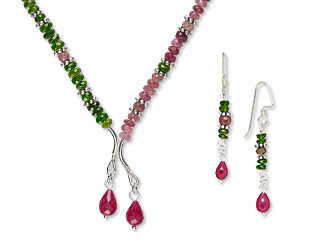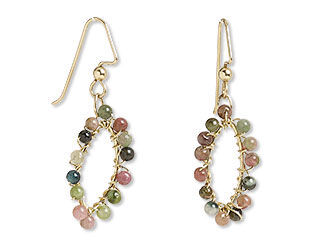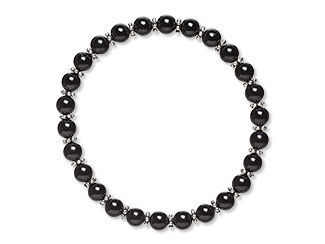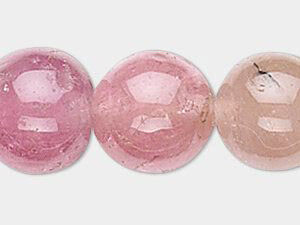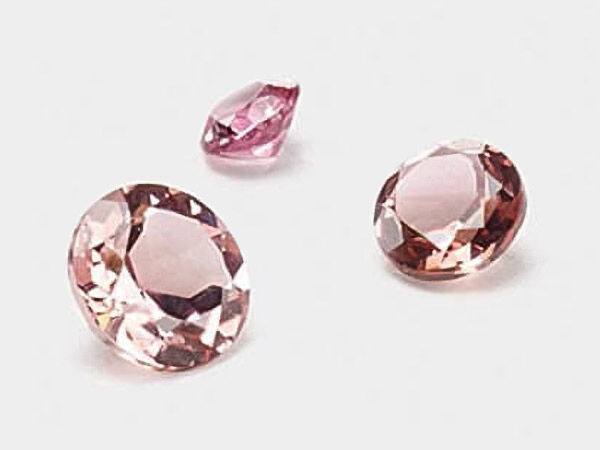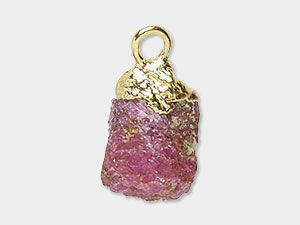Tourmaline Meaning and Properties
Tourmaline History
Tourmaline holds a special place in the hearts of jewelry designers and gemstone enthusiasts. All possible color combinations imaginable are embodied in this gemstone. It is believed that tourmaline is found in all these colors because it traveled along a rainbow and shone in all the rainbow's colors.
Tourmaline was known for centuries by the name schrol, but the name tourmaline comes from the Sinhalese (Sri Lanka) words tura mali meaning "unknown gemstones of mixed colors." Colored tourmaline crystals would be grouped together in tura mali parcels in Sri Lanka and exported to Europe in the beginning of the 18th century.
Tourmaline's worldwide popularity is based on two key facts:
- It is a bright and beautiful gemstone that can be found in so many colors.
- It is a high-quality material that is still affordable for use in jewelry designs.
Tourmaline displays a greater range of colors than almost any other known gemstone. The most common color available is black, but every color of the rainbow can be found. There is a tourmaline color that can mimic almost any other gemstone. This is why it is one of the most interesting gems to gemologists and jewelry designers. At one time, red tourmalines were thought to be other gemstones! Many stones in the Russian Crown jewels from the 17th century—once thought to be rubies—are actually tourmalines.
Tourmaline is renowned as the gem of sensitive poets and creative artists. (Shakespeare even had a small collection of tourmaline jewelry to help him overcome writer's block.) Tourmaline is believed to inspire creativity and was used extensively as a talisman by artists and writers from the Renaissance through the Victorian Age.
The rarest member of the tourmaline family is the pink tourmaline. In fact, it is even rarer than a ruby! The Empress Dowager Tz'u-hsi (tzoo-she), the last Empress of China, adored and avidly collected pink tourmaline. During her lifetime, she bought nearly a ton of it from the Himalaya Mine in California, USA. When she died, she was laid to rest among all her jewels, and her head was set upon a prized pillow of carved pink tourmaline.
When heated or rubbed, tourmaline acquires an electric charge and attracts small objects like dust, ashes and other lightweight objects, much like amber. This phenomenon is called piezoelectricity (pay-zoh-electricity), and it is considered a unique property. The first documented record of piezoelectricity is in the early 18th century.
In addition to its use in jewelry, tourmaline has been employed in pressure devices because of its piezoelectric properties. It has been used in sonar apparatus and other devices that detect and measure variables of pressure, too.
Because of its electric charge capabilities, the demand for tourmaline increased during WWII for the production of pressure sensitive gauges for submarine sonar instrumentation as well as other war equipment that became significant.
What are the Metaphysical Properties of Tourmaline?
The pink tourmaline's status as the October birthstone is shared with the opal, and there are many unique metaphysical tourmaline properties in each of its varieties. The piezoelectric property of the stone can help polarize people's emotions and energy with a magnetic-electric charge that appears when the crystal is rubbed or heated.
Tourmaline is thought to be for people who bear a broken heart, as it encourages love, gently disperses emotional pain and dissolves disruptive feelings. It calms the negative emotions that upset relationships. It is also considered an aphrodisiac, helping people realize when it is safe to love and when it is time to overcome sorrow or traumatic memories. It introduces the presence of compassion and wisdom when dealing with others because it is thought to promote flexibility of thought and open-mindedness.
All colors of tourmaline are thought to be powerful. Each person seems to have a different reaction to tourmaline.
Pink tourmaline is highly valued by people that have difficulty dealing with fear and suffer from panic attacks or are in need of something to help them heal their inner chaos and dread. Pink tourmaline represents a love of humanity and humanitarianism. It is worn to promote sympathy towards others. It is an excellent stone for healers and counselors because it promotes better listening and understanding. It carries the virtue of unconditional love and friendship. In fact, pink tourmaline radiates the highest amount of love of all the different colored tourmalines.
Watermelon tourmaline (pink with a green outer edge) has been said to be a stone of reconciliation, a stone that fosters compassion and cool headedness, radiates the energy that attracts money, healing and friendship while stabilizing, grounding and reaffirming our Earth roots.
Blue tourmaline creates a commitment towards the completion of one's goals and is said to protect the wearer against dangers.
Black tourmaline repels negative energy. It is suggested to carry this stone when you feel surrounded by negativity, and it is great for use in times of crisis or extreme stress. It will protect the wearer until they are strong enough in on their own power by breaking through old patterns and fears and cultivating inner wisdom, courage, stability and patience.
Red tourmaline builds inner strength and wisdom because it unites the heart and body in love and passion. It also brings joy, openness, emotional stability, compassion and devotion.
What is Tourmaline Made From?
Though tourmaline has been found in parts of Africa and Europe, the most prominent mine locations are established in North and South America. It is not uncommon for minute cracks to be filled in with resin or plastic to improve durability and appearance.
Many tourmaline crystals exhibit polarity—the crystal has a different charge at either end of the crystal, making it naturally magnetic.
Tourmaline comes in a wide family of varieties. The red colors are called rubellite and blue colors are indicolite. Other colored tourmaline names are verdite for greens, dravite for browns, achroite for the rare colorless tourmalines, schorl for the most common blacks and paraiba for a particularly rare vivid green variety.
Different colors of tourmaline are often confused with different gemstones. A few of these gemstones are iolite, topaz, citrine, amethyst, spinel, ruby, emerald, smoky quartz, aquamarine and tsavorite garnet.
- Mineral Information: Aluminum borate silicate
- Chemical Composition: (Na or CA)1(Mg, Li, Al and/or Fe2+)3Al6(BO3)3Si6O18(OH)4
- Color: Most commonly black, but can range from brown, gold, blue, violet, green, pink, or a dual-colored pink and green.
- Hardness: 7 to 7-1/2 (Mohs)
- Specific Gravity: 3.02 – 3.26
- Refractive Index: 1.616 – 1.652
How Do You Clean Tourmaline?
Do not store tourmaline with harder gemstones or other materials that might rub against it and cause damage. As with all gems, protect tourmaline from scratches and sharp blows that could shatter it. Also, avoid large temperature changes that can cause the crystal to fracture (such as leaving it near a heater vent or in a hot car).
Do not clean tourmaline in a home ultrasonic cleaner! Tourmaline jewelry can be cleaned with a mild solution of gentle dishwashing detergent and water at home. Soak the stone for 10-20 minutes, then wipe gently but firmly with a wash towel.
Tourmaline FAQ
Q: Is tourmaline a precious gemstone?
A: Tourmaline is considered a semi-precious gemstone, although some varieties are as rare and costly as precious gems.
Q: What is paraiba tourmaline?
A: Paraiba tourmaline was first discovered in 1989 in Paraiba, Brazil. Its vibrant blue-green color comes from copper. Later, deposits of copper-infused tourmaline were found in Nigeria and Mozambique, and all were given the name paraiba tourmaline due to their chemical similarity.
Q: What does tourmaline symbolize?
A: Tourmaline is a powerful and versatile crystal known for its wide range of symbolic meanings, which stem from its remarkable variety of colors. Recognized across cultures and healing traditions, tourmaline properties are often linked to protection, energetic cleansing and emotional balance.
Q: Can tourmaline get wet?
A: It is safe for tourmaline to get wet briefly. With its Mohs hardness of 7 to 7-1/2, it will not dissolve or disintegrate. Do not soak tourmaline. Because of its natural fractures and inclusions, it can be weakened or split by prolonged exposure to water.
Designing with Tourmaline
The majority of fine-cut tourmaline is faceted. Colored tourmaline beads can be fashioned into bracelets, pendants, rings, earrings and other pieces of jewelry. Of the entire array of colors available, the green and pink watermelon variety has become the most popular.
Imagine making a head-turning entrance wearing flashing tourmaline crystal beaded jewelry set off by diamond-clear quartz crystals, shimmering sparkles of aquamarine, and golden vermeil.
Pair up watermelon tourmaline in compelling combinations of pink and green with crystal components, peridot, black onyx, cultured freshwater pearls and luscious precious metal beads in a host of exotic designs that will radiate opulence!
A Few Design Inspirations to Get You Started
Shop for Tourmaline
**Please note that all metaphysical or healing properties listed are collected from various sources. This information is offered as a service and not meant to treat medical conditions. Fire Mountain Gems and Beads® does not guarantee the validity of any of these statements.
How did you like this resource? Your feedback helps us provide resources that matter to you most.
Copyright Permissions
All works of authorship (articles, videos, tutorials and other creative works) are from the Fire Mountain Gems and Beads® Collection, and permission to copy is granted for non-commercial educational purposes only. All other reproduction requires written permission. For more information, please email copyrightpermission@firemtn.com.

